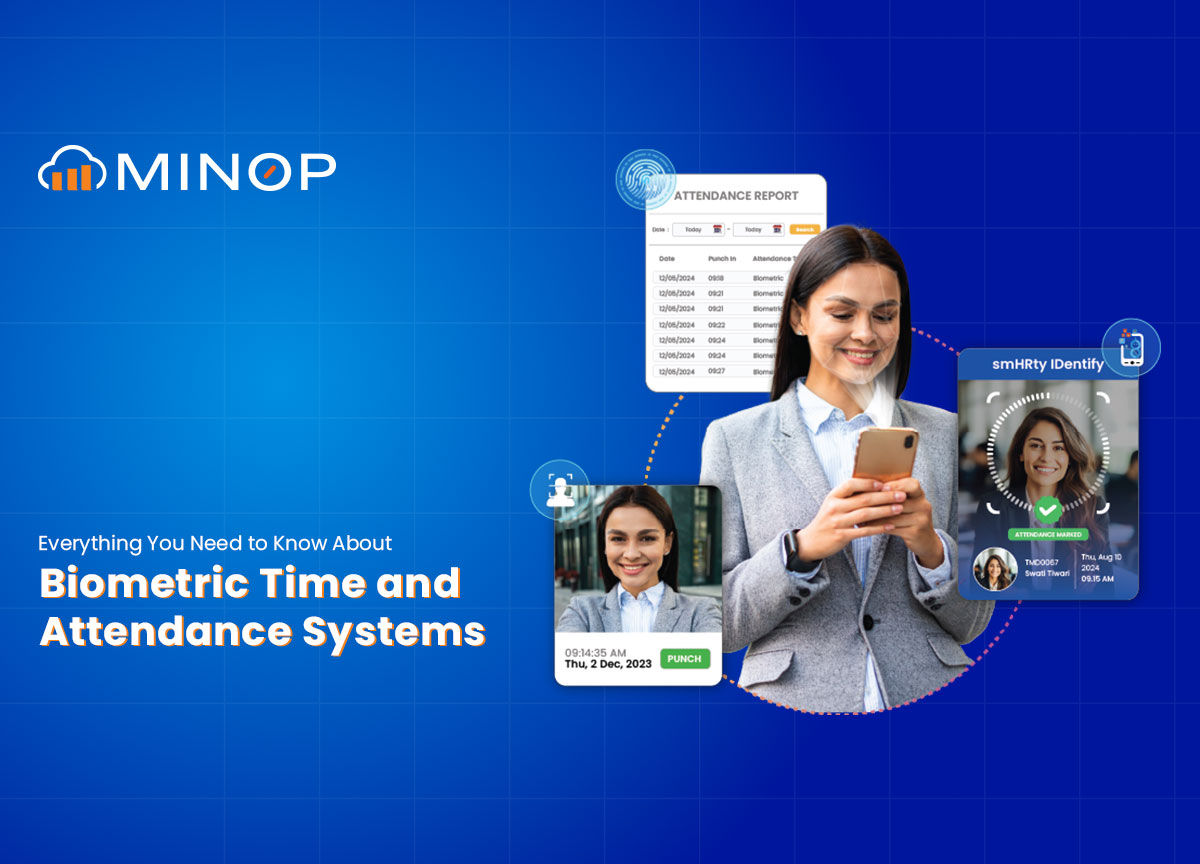Everything You Need to Know About Biometric Time and Attendance Systems
Posted On:- 15 April, 2025 By:- Vaibhav Maniyar
According to a biometric time and attendance systems survey, digital identity is considered the biggest development in biometrics and is forecast to grow to $15.42 billion by 2028. An average time and attendance system stems from a simple idea of maintaining productivity and finding loose ends efficiently. From a biometric standpoint, it adds a layer of security to verify identity and ensure the recorded time data truly belongs to the specific employee. But when we started to use biometrics to measure time and attendance and how efficient it has been over the years. Let’s understand in detail.
Evolution of Biometric Systems
A century ago, we didn’t have forensic science to detect fingerprint fraud but contracts and seals, transactions often took place in front of witnesses. The way a person pressed their finger was unique because of angle, pressure, and texture and was hard to replicate exactly.
Since biometric involves facial, iris, and even voice recognition for time and attendance here, “bio” means life and “metric” means measure. What we are doing here is measuring the biological patterns of a person and turning it into millions of ones and zeros. Furthermore, this binary data is used for time and attendance systems.
As mentioned earlier, the evolution of such systems had a very interesting start. Initially, fingerprint classification systems were taken into use for identification of criminals - not time and attendance. For instance, the Henry classification system was the earliest system in record to take thumb print for data. Later, this system was the basis of modern-day AFIS (Automated Fingerprint Identification System) classification methods up until the 1990s.
For clarity, the Henry classification system worked by a simple method. Here, each finger on both hands is assigned a number from 1 to 10 and then are grouped by patterns. (Right thumb = 1, right index = 2, … left pinky = 10.)
The system focuses on three main fingerprint patterns:
Loops (most common)
Whorls
Arches (least common)
If it has a loop or arch, it gets a 0. If a finger has a whorl, it gets a numerical value.
The sum of the values from whorled fingerprints on even-numbered fingers is added together, and then 1 is added to this sum. Similarly, the sum of the values from whorled fingerprints on odd-numbered fingers is calculated, and again, 1 is added to this sum.
The final number is obtained by dividing the even-finger sum +1 by the odd-finger sum +1 which helps categorize and index fingerprints, making it easier for forensic experts to search and match fingerprint records efficiently.
This system has been a highly influential force in the formation of current IAFIS technology (Integrated Automated Fingerprint Identification System) which is a computerized system maintained by the Federal Bureau of Investigation (FBI) since 1999 till present day.
Advent of Time and Attendance
For a system to merge the biometric concept and time and attendance together, it is important to take note of a simple process i.e., attaching a number when a fingerprint or a face is recognized.
The earliest generation of biometric attendance systems stored raw templates on local devices, often unencrypted and prone to spoofing. Over time, the industry pivoted toward using hashed templates which are mathematically irreversible representations of biometric features. They help to render reverse-engineering infeasible even in the event of data breaches.
In the late 1990s and early 2000s, the primary innovation wasn’t just biometric capture—it was the architectural shift to distributed verification systems. Rather than performing all matching on-device, some systems began pushing encrypted biometric tokens to central databases for 1:N (identification) or 1:1 (verification) matching. This allowed for real-time attendance tracking across multiple geographic sites, all linked through WAN or later VPN-secured cloud infrastructure.
As spoofing methods evolved, the biometric industry responded with entropy engineering—injecting randomness or contextual binding into the biometric session. For example, modern face recognition systems in time and attendance applications now include liveness detection, challenge-response sequences (like blinking or head-turning), and even thermal pattern mapping to ensure the face is live and not a print, mask, or 3D model.
Fingerprint systems began incorporating capacitive differential thresholds—not just detecting the ridge pattern, but how the tissue capacitance changed under pressure variation over milliseconds. The entropy, or unpredictability, in how biometric traits respond to dynamic conditions became a crucial element in strengthening the security of time logs.
On-Edge Biometrics vs Central Matching Systems
A less-discussed shift in modern systems is the deployment of edge-based biometric processing. Instead of transmitting raw biometric data to central servers, algorithms are now being deployed at the edge—on the device itself—using embedded GPUs or specialised biometric SoCs (System-on-Chip). These devices run pre-trained attendance API models that can make real-time decisions without needing to query the cloud. This not only reduces latency but also strengthens privacy since biometric data doesn’t leave the local network.
However, edge processing brings with it the challenge of model synchronisation. If an employee is enrolled in one location, how is that template synchronised securely with hundreds of decentralised edge nodes? This is where federated learning and secure template propagation protocols are being explored. Instead of syncing templates, the devices sync learning—updating the model parameters based on new data without exposing the data itself.
Related: How Does A Face Recognition Attendance System Work?
Deep in the architectural layer, GDPR and similar frameworks have triggered innovations in biometric system design itself, not just data policy. Under GDPR, biometric data is classified as “special category” data, requiring not just consent but demonstrable minimisation and purpose-limitation principles. This has led to the rise of on-demand biometric matching, where no persistent template is stored—each authentication session involves transient matching and then purging the template instantly.
Some systems now integrate zero-knowledge proof protocols, allowing verification of identity or attendance without ever revealing the actual biometric data. This is a significant departure from traditional match-on-file models and aligns with privacy-first architectures being pushed in post-GDPR environments.
Future of Biometric Time and Attendance Systems
The most forward-looking systems are no longer viewing biometric time and attendance as administrative tools-they’re treating them as data-rich inputs for enterprise intelligence. Consider systems that analyse biometric timestamps to extract:
Peak productivity windows based on real-time heat maps of presence data.
Anomalous fatigue detection via facial micro-expression analysis across weeks.
Team interaction heatmaps derived from cross-sectional co-presence data.
This transforms biometric systems from compliance tools into behavioural insight engines. The fusion of biometric, temporal, and environmental data gives enterprises the ability to not just track hours, but to quantify operational rhythms and workforce dynamics.
Factors to Consider When Choosing a Biometric Time and Attendance System
Getting the right Biometric Time and Attendance System is key. It’s not just tech shopping; it’s finding what genuinely works for your business. Here’s what to think about:

Work Environment
First up, your Work Environment. Is it a pristine office? A dusty factory? A building site? A clean hospital wing? This heavily guides your choice of biometric tech. Fingerprint scanners might choke on workshop grease. Facial or hand geometry could be better there. Need high hygiene? Contactless like facial or iris is the way to go.

Number of Employees and Scalability
Then, Number of Employees and Scalability. Can the system handle your current team size without queues forming? Can it grow with you? Check user limits. Check template storage capacity. Figure out how many biometric machines you need based on staff numbers and where they need to clock in. Avoid bottlenecks.

Accuracy Requirements
Accuracy Requirements matter. All biometrics aim for accuracy, but some are sharper than others (iris is top tier). How much precision do you really need? For most, fingerprint and facial strike a good balance between being accurate enough and easy to use.

Integration Capabilities
Integration Capabilities are huge. Does the Biometric Time and Attendance System play nice with your payroll software? Your HR system? Your ERP? Smooth integration saves tons of admin time, stops data entry errors, keeps info consistent everywhere. Check compatibility. Ask about APIs or specific integration tools.

Budget
Budget is always on the list. Look at the total cost. That’s the initial hardware (biometric attendance machine price – and yes, the fingerprint attendance machine price differs from facial scanner costs), software licences, getting it installed, training people, plus any ongoing fees. Weigh this against savings from stopping time theft, fewer errors, and less admin work. Understand the ROI. The cheapest kit isn't always the best long-term value.

Ease of Use
Think about Ease of Use. If it's fiddly, staff won't like it. It needs to be simple for daily clocking. The admin software also needs to be user-friendly for HR or payroll to manage things. Factor in training time.

Security and Data Privacy
Security and Data Privacy are non-negotiable. Especially with rules like GDPR. How does the system store biometric data (remember, usually templates, not images)? Is it encrypted? What's the vendor's privacy policy? Make sure it meets data protection laws where you operate. Be open with employees about how their data is handled. Trust matters here.

Vendor Support and Reliability
Finally, check Vendor Support and Reliability. Go with a known vendor. Someone with a track record. What support do they offer? Are software updates part of the deal? Look for reviews. Ask for references. A good biometric time and attendance System needs solid backup such as Minop for the long haul.
Related: What is Employee Leave Management System and How Does it Work?
Minop: Making the Right Choice for Your Business
Bringing in a Biometric Time and Attendance System like Minop is smart. It’s a move towards running tighter, cleaner, safer. Understanding what they are, how they use unique traits like fingerprints or faces, and the real benefits – stopping time theft, making payroll easy – shows their power.
Thinking carefully about the tech types, your workplace, how systems connect, the budget (including that biometric attendance machine price), and privacy issues helps you choose wisely. Whether it's a solid fingerprint attendance system, a slick facial recognition setup, or something else, the aim's the same: time tracking that’s precise, easy, and trustworthy.
The days of dodgy timesheets and easy-to-cheat cards are numbered. Biometric Time and Attendance Systems are how modern workforce management gets done. They give businesses solid data, cut waste, and free up people from boring admin. Ready to step up your operations? Looking into your options is the first move towards a more controlled, more productive business.
Frequently Asked Questions
1. What is the primary benefit of using biometric time and attendance?
The main benefit is accurate and reliable employee time tracking by verifying identity using unique biological traits (like fingerprints or faces), which eliminates "buddy punching" and reduces payroll errors.
2. What are common types of biometric technology used for attendance?
The most common types include fingerprint scanning and facial recognition. Iris scanning, hand geometry, and voice recognition are also used in some systems.
3. Are biometric attendance systems secure regarding employee data?
Modern systems prioritise security and privacy. They typically store encrypted mathematical templates of biometric data, not actual images. Choosing vendors compliant with regulations like GDPR and having clear data policies is crucial.
4. What factors are important when selecting a biometric system for my company?
Key factors include the work environment (e.g., office vs. factory), number of employees, required accuracy, integration with payroll/HR software, budget (including hardware and software costs), ease of use for employees, data security measures, and vendor reliability.

Comments